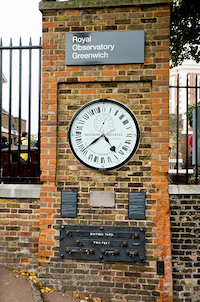GMT: World Timekeeping Standard
Greenwich Mean Time (GMT) is the time measured at the Royal Observatory in Greenwich, London, United Kingdom. GMT was used as the standard for worldwide time for many years and is still the standard for several countries around the world. People around the world have used various methods of keeping time for a very, very long time; and one thing that timekeepers have been aware of for a great many years is that solar time, based on the Earth's orbits around the Sun, is different from mean time, what terrestrial clocks measure. The invention of the pendulum clock, by Christiaan Huygens in 1656, was a giant step forward in standardizing timekeeping. The English scientist John Flamsteed developed a formula for converting solar time to mean time and, in the early 1670s, published a set of conversion tables. Impressed with this achievement, King Charles II appointed Flamsteed Astronomer Royal and offered him the run of the Royal Observatory in Greenwich. Flamsteed did some fancy calculations and then determined the average time when the Sun crossed the meridian at his fixed point in time, Greenwich. This was the advent of Greenwich Mean Time. That was all well and good as a concept, but it didn't mean much to the general public–for several years, anyway. As the desire for exploration consumed more and more nautical explorers in the 18th century, the need arose for keeping accurate time while at sea. Nevil Maskelyne, Astronomer Royal in 1767, introduced the Nautical Almanac, a series of data tables based on celestial timekeeping. The time standard that these tables used was GMT. It was GMT, of course, that was instrumental in the English scientist John Harrison's invention of the chronometer that finally facilitated the calculation of longitude. And with that success, people in many other countries began to follow Harrison's example and, by extension, using GMT as the standard for timekeeping. 
But royal astronomers and world explorers are not the local populace, and so people around the world who were living normal lives and using traditional methods of keeping time continued doing what they had been doing for many years, which was using the Sun as a basis for this timekeeping. As a result, a person traveling from one location to another could find a difference in what time people said it was that varied from slight to very noticeable. For example, people in western England might use Bristol Mean Time as their standard and be 10 minutes behind GMT. Such a discrepancy might not have been much to compensate for in the vast portion of timekeeping history, but it was a potentially huge amount of time when the need for coordinating railroad timetables came along. In the mid-19th Century, the United States and the United Kingdom led the way in laying hundreds of miles of track, building hundreds of locomotives and railway cars, and otherwise setting up railroad networks. The companies running those railroads in the U.K. adopted GMT as their standard time for all of their operations; that decision might have been enough to force such a practice into becoming the kingdom-wide standard, but the Railway Clearing House in 1847 cemented the deal, forcing most public clocks across the kingdom to be set to GMT. Parliament made it official in 1880. A mere four years later, GMT became the universal standard for world timekeeping, agreed at the International Meridian Conference, which took place on November 1, 1884, in Washington, D.C. By that time, nearly three-quarters of all of the world's trade used nautical charts that had been determined using GMT as their timekeeping standard. So GMT it was. At the same time, people around the world agreed to setting up the 24 time zones that we have today. Things stayed that way until 1972, when a new international agreement created Coordinated Universal Time (UTC). This is based on the time kept by atomic clocks, which are considered to be very much more accurate than other clocks because scientists have identified that the daily rotation of Earth is irregular. It is these atomic clocks that are the standard for satellite systems such as GPS. GMT is still the time standard for the United Kingdom and for these other countries: Burkina Faso, Gambia, Ghana, Guinea, Guinea-Bissau, Iceland, Ireland, Ivory Coast, Liberia, Mali, Mauritania, Portugal, Senegal, Sierra Leone, and Togo. |
|
Social Studies for Kids
copyright 2002–2024
David White




